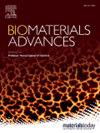3D printed cell-free bilayer porous scaffold based on alginate with biomimetic microenvironment for osteochondral defect repair
IF 6
2区 医学
Q2 MATERIALS SCIENCE, BIOMATERIALS
Materials Science & Engineering C-Materials for Biological Applications
Pub Date : 2024-10-31
DOI:10.1016/j.bioadv.2024.214092
引用次数: 0
Abstract
Despite significant progress in repairing osteochondral injuries using 3D printing technology, most cartilage layer scaffolds are made of degradable materials, making it difficult to simultaneously provide extracellular matrix functionality while replicating the mechanical properties of natural cartilage layers. Additionally, their degradation rate is challenging to align with cartilage regeneration. Furthermore, double-layer scaffolds commonly used for repairing osteochondral often exhibit inadequate bonding between the cartilage layer scaffolds and bone layer scaffolds. To solve these problems, we presented a bilayer scaffold composed of a 3D printed non-degradable thermoplastic polyurethane (TPU) scaffold filled with hydrogel (Gel) made of gelatin and sodium alginate as the cartilage layer (noted as TPU/Gel), meanwhile, a 3D printed polylactic acid (PLA) scaffold containing 10 % hydroxyapatite (HA) as the bone layer (noted as PLA/HA). At the junction of the bone layer and cartilage layer, TPU tightly bonded with the bone layer scaffold under high temperatures. The hydrogel filling within the TPU layer of cartilage served not only to lubricate the joint surface but also aided in creating a 3D microenvironment. The non-degradable nature of TPU allowed the cartilage layer scaffold to seamlessly integrate with the surrounding regenerated cartilage, achieving permanent replacement and providing shock absorption and weight-bearing effects. This effectively addressed the mechanical challenges associated with cartilage regeneration and resolved the inconsistency between cartilage regeneration and material degradation rates.
基于海藻酸盐的三维打印无细胞双层多孔支架,具有用于骨软骨缺损修复的仿生微环境。
尽管在利用三维打印技术修复骨软骨损伤方面取得了重大进展,但大多数软骨层支架都是由可降解材料制成的,因此很难在复制天然软骨层机械特性的同时提供细胞外基质功能。此外,它们的降解率也很难与软骨再生相匹配。此外,通常用于修复骨软骨的双层支架往往表现出软骨层支架和骨层支架之间的粘合不足。为了解决这些问题,我们提出了一种双层支架,由填充有明胶和海藻酸钠制成的水凝胶(Gel)的三维打印不可降解热塑性聚氨酯(TPU)支架作为软骨层(简称TPU/Gel),同时由含有10%羟基磷灰石(HA)的三维打印聚乳酸(PLA)支架作为骨层(简称PLA/HA)。在骨层和软骨层的交界处,热塑性聚氨酯在高温下与骨层支架紧密结合。软骨热塑性聚氨酯层中的水凝胶填充物不仅起到润滑关节表面的作用,还有助于创造三维微环境。热塑性聚氨酯的不可降解性使软骨层支架能与周围的再生软骨无缝结合,实现永久替代,并提供减震和承重效果。这有效解决了与软骨再生相关的机械难题,并解决了软骨再生与材料降解率不一致的问题。
本文章由计算机程序翻译,如有差异,请以英文原文为准。
求助全文
约1分钟内获得全文
求助全文
来源期刊
CiteScore
17.80
自引率
0.00%
发文量
501
审稿时长
27 days
期刊介绍:
Biomaterials Advances, previously known as Materials Science and Engineering: C-Materials for Biological Applications (P-ISSN: 0928-4931, E-ISSN: 1873-0191). Includes topics at the interface of the biomedical sciences and materials engineering. These topics include:
• Bioinspired and biomimetic materials for medical applications
• Materials of biological origin for medical applications
• Materials for "active" medical applications
• Self-assembling and self-healing materials for medical applications
• "Smart" (i.e., stimulus-response) materials for medical applications
• Ceramic, metallic, polymeric, and composite materials for medical applications
• Materials for in vivo sensing
• Materials for in vivo imaging
• Materials for delivery of pharmacologic agents and vaccines
• Novel approaches for characterizing and modeling materials for medical applications
Manuscripts on biological topics without a materials science component, or manuscripts on materials science without biological applications, will not be considered for publication in Materials Science and Engineering C. New submissions are first assessed for language, scope and originality (plagiarism check) and can be desk rejected before review if they need English language improvements, are out of scope or present excessive duplication with published sources.
Biomaterials Advances sits within Elsevier''s biomaterials science portfolio alongside Biomaterials, Materials Today Bio and Biomaterials and Biosystems. As part of the broader Materials Today family, Biomaterials Advances offers authors rigorous peer review, rapid decisions, and high visibility. We look forward to receiving your submissions!

 求助内容:
求助内容: 应助结果提醒方式:
应助结果提醒方式:


